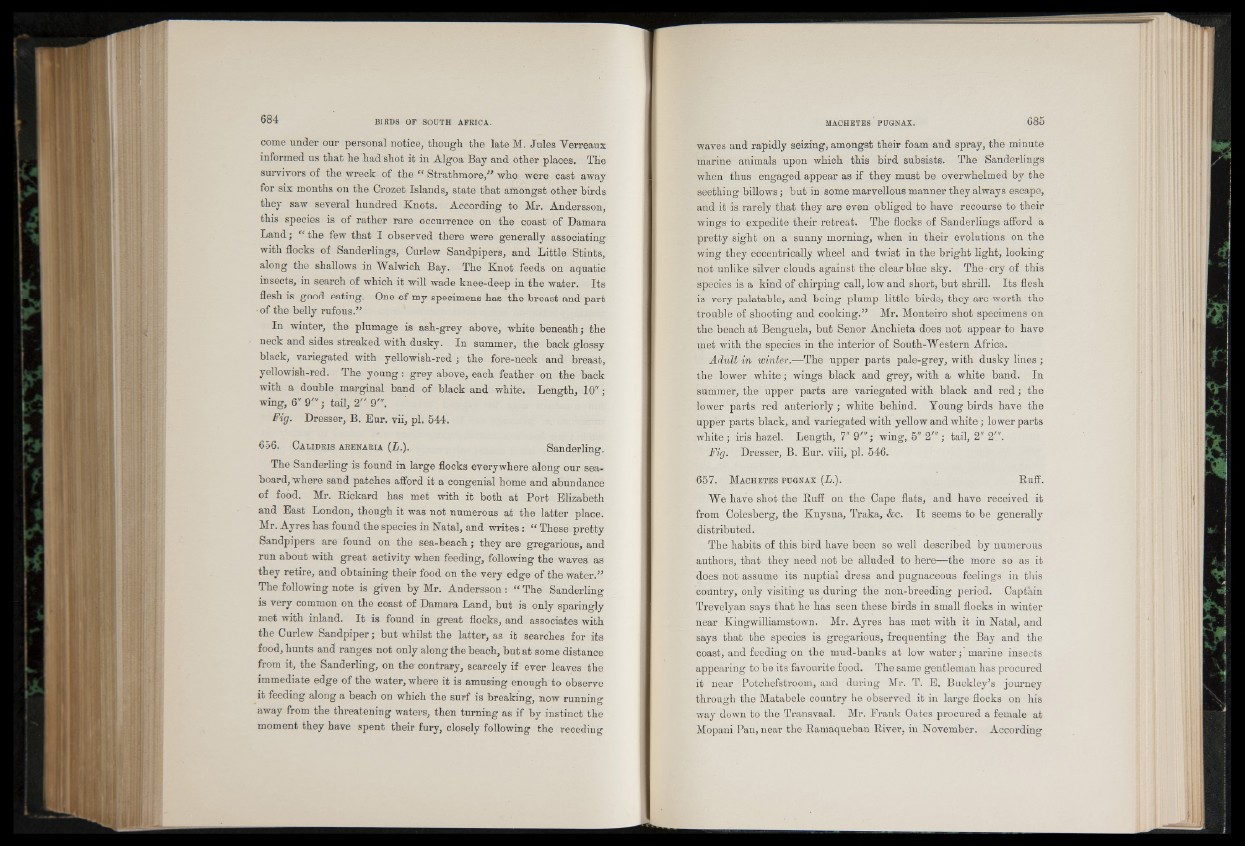
come under our personal notice, though the late M. Jules Verreaux
informed us that he had shot it in Algoa Bay and other places. The
survivors of the wreck of the “ Strathmore,” who were cast away
for six months on the Crozet Islands, state that amongst other birds
they saw several hundred Knots. According to Mr. Andersson,
this species is of rather rare occurrence on the coast of Damara
Land; “ the few that I observed there were generally associating
with flocks of Sanderlings, Curlew Sandpipers, and Little Stints,
along the shallows in Walwich Bay. The Knot feeds on aquatic
insects, in search of which it will wade knee-deep in the water. Its
flesh is good eating. One of my specimens has the breast and part
•of the belly rufous.”
In winter, the plumage is ash-grey above, white beneath; the
neck and sides streaked with dusky. In summer, the back glossy
black, variegated with yellowish-red ; the fore-neck and breast,
yellowish-red. The young: grey above, each feather on the back
with a double marginal band of black and white. Length, 10";
wing, 6" 9"'; tail, 2" 9'".
Fig. Dresser, B. Eur. vii, pi. 544.
656. C a l id r i s a r e n a r ia (L.). Sanderling.
The Sanderling is found in large flocks everywhere along our seaboard,
where sand patches afford it a congenial home and abundance
of food. Mr. Rickard has met with it both at Port Elizabeth
and East London, though it was not numerous at the latter place.
Mr. Ayres has found the species in Natal, and writes: “ These pretty
Sandpipers are found on the sea-beach; they are gregarious, and
run about with great activity when feeding, following the waves as
they retire, and obtaining their food on the very edge of the water.”
The following note is given by Mr. Andersson : if The Sanderling
is very common on the coast of Damara Land, but is only sparingly
met with inland. It is found in great flocks, and associates with
the Curlew Sandpiper; but whilst the latter, as it searches for its
food, hunts and ranges not only along the beach, but at some distance
from it, the Sanderling, on the- contrary, scarcely if ever leaves the
immediate edge of the water, where it is amusing enough to observe
it feeding along a beach on which the surf is breaking, now running
away from the threatening waters, then turning as if by instinct the
moment they have spent their fury, closely following the receding
waves and rapidly seizing, amongst their foam and spray, the minute
marine animals upon which this bird subsists. The Sanderlings
when thus engaged appear as if they must be overwhelmed by the
seething billows; but in some marvellous manner they always escape,
and it is rarely that they are even obliged to have recourse to their
wings to expedite their retreat. The flocks of Sanderlings afford a
pretty sight on a sunny morning, when in their evolutions on the
wing they eccentrically wheel and twist in the bright light, looking
not unlike silver clouds against the clear blue sky. The • cry of this
species is a kind of chirping call, low and short, but shrill. Its flesh
is very palatable, and being plump little birds, they are worth the
trouble of shooting and cooking.” Mr. Monteiro shot specimens on
the beach at Benguela, but Senor Anchieta does not appear to have
met with the species in the interior of South-Western Africa.
Adult in winter.S-The upper parts pale-grey, with dusky lines ;
the lower white; wings black and grey, with a white band. In
summer, the upper parts are variegated with black and red; the
lower parts red anteriorly; white behind. Young birds have the
upper parts black, and variegated with yellow and white; lower parts
white; iris hazel. Length, 7" 9"'; wing, 5" 2"'; tail, 2" 2'".
Fig. Dresser, B. Eur. viii, pi. 546.
657. M a che tes puqnax (L.). Ruff.
We have shot the Ruff on the Cape flats, and have received it
from Colesberg, the Knysna, Traka, &c. It seems to be generally
distributed.
The habits of this bird have been so well described by numerous
authors, that they need not be alluded to here—the more so as it
does not assume its nuptial dress and pugnaceous feelings in this
country, only visiting us during the non-breeding period. Captain
Trevelyan says that he has seen these birds in small flocks in winter
near Kingwilliamstovvn. Mr. Ayres has met with it in Natal, and
says that the species is gregarious, frequenting the Bay and the
coast, and feeding on the mud-banks at low water; marine insects
appearing to be its favourite food. The same gentleman has procured
it near Potchefstroom, and during Mr. T. E. Buckley’s journey
through the Matabele country he observed it in large flocks on his
way down to the Transvaal. Mr. Frank Oates procured a female at
Mopani Pan, near the Ramaqueban River, in November. According